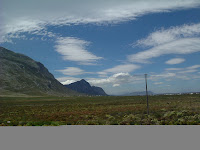
Tuesday, February 23, 2010
Psy-trance Culture
a. The Other
b. Organisation
c. Space
A general romantic view of subcultures sees them as being nomadic and displaced, making it difficult for them to identify with a certain place. The opposing view is that subcultures have a strong sense of place and identities are formed around a fix location (Gelder & Thornton, 1997: 315). Trance culture falls into both these categories. Gatherings are held in a variety of locations, but there are some locations which are regularly used. Everyone I spoke to have their own favourite location. Oscar, for instance, is especially enamored by the Theewaters Kloof Dam where gatherings are regularly held, while Thompson recalls having his most meaningful experiences at the Nekkies Resort in
d. Language
Trancees also have their own vocabulary. The word ‘aweh’ is used a lot and has a variety of different meanings. It can be used as a greeting, for example to replace the word ‘hello’. It is also used as confirmation, for instance, one would ask “would you like to go to the dance floor?” and the reply would be “aweh”. Another use for “aweh” would be to express happiness and well being, by exclaiming “aweh”. There are a variety of words for ‘dance’, for example “stomping”, “grinding” and “boogey” are the more commonly used. The term ‘irie’ has been expropriated from Rastafarian culture to describe a friendly atmosphere or to describe a good deed, as in “it was really irie of him to help us get the car started.” There are countless more examples which I will not go into here.
e. Technology
Technology plays an important role within Trance culture. While they do not create their own technologies, they make use of existing technology in their own way. This is especially so with Djs and producers of music. Music produced for Trance parties are made by music synthesizers. Synthesizers are often modified to produce the unique sounds that are found within trance music. The amplifiers used at gatherings are also state of the art, and ‘Vortex’ is said to be host to one of the loudest sound system in the world, reaching up to 90 kilo-watt of sound. Thompson recalls his astonishment at watching the metal bins vibrate during one gathering.
Within the community there is an active economy. This can mostly be seen at the stall area of a gathering where various items such as food, clothes and curios are sold. I spoke to some vendors and according to many their shops are their main source of income during the summer. They attend a gathering every weekend where they would sell their wares or foods. Prices of goods tend to be very high. For example, a bottle of water costs R20 and a ‘Psy-Trance Hoody’ would cost you R150. Selling of drugs is also very prominent within the community. Drug dealers make a lot of money, especially at bigger gatherings. I spoke to a dealer who said that he has made over R50, 000 at one gathering.
In the case of master/apprentice, within the trance community this can be translated into older members introducing newer members to the Trance lifestyle. All my interviewees said that they were introduced to the scene by older members. They are all in accord that their initial experiences were overwhelming and that guidance as to how things work was very important to them. Older members would explain how certain drugs work and of what drugs to be careful, as well as acting as role models on how to approach dancing and other people.
h. Ritual
Dancing is an important activity for the community. All those who I interviewed said they feel in unity with each other and with the universe when dancing. Thompson says that after attending a gathering he can be physically exhausted to a point where he cannot even stand but that his mind has been “spiritually recharged”. Music and dance gives people at these events a sense of purpose. Hector says that at one gathering he had ‘lost’ himself on LSD, but when he started to dance he realised why he was there and who he was.
Trance Party
In my third year I did a small project on the 'Psychedelic Trance' scene which is quite big in the Western Cape. It turned out to be a really good project and I did very well, but I don't feel I really managed to capture what goes on there. In the end it seemed more like the outline for a parody than anything. I think my perspective is a little biased because Psy-trance begins to work on my nerves when I'm exposed to it for long periods of time. Here is a small excerpt from my journal for a party I went to with two of my friends who" I know to be familiar with the ‘scene’"....
C. The Gathering
We arrived at the gate where we each paid a R140 entrance fee. Security guards wearing red shirts directed us to a large parking area where we immediately parked the car. Oscar and Peterson were in hurry to purchase their drugs so they could relax and start enjoying the party. I agreed it was a good idea to get it out of the way. I was interested to see how long it would take them to acquire the drugs. Oscar was looking to find LSD, while Peterson wanted ‘magic mushrooms’. Oscar suggested we go search in the stall area as that is where drugs are more commonly found.
01: 36
10: 30
The three of us are tired and want to go home. It has been a long night. Peterson is contented and continuously amuses us with his sharp wit. Oscar seems collected but his attitude toward the party and the people is not very positive. He is upset by the ‘wastefulness’ he sees and the people ‘freak him out’.








